
PREV ARTICLE
NEXT ARTICLE
FULL ISSUE
PREV FULL ISSUE
SOME VERY ODD DENOMINATION TOKENSDick Hanscom edits the Alaskan Token Collector & Polar Numismatist. The July 2020 issue includes an interesting discussion of two rather odd denomination tokens. With permission, we're republishing it here for E-Sylum readers. The "Editor's comments" here are Dick's. -Editor WHY A $1.20 TOKEN? 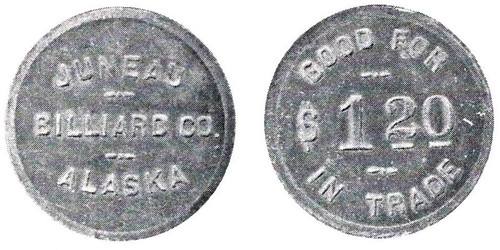
A Juneau Billiard Co. $1.20 token (B-32c) recently sold on eBay for the opening bid of $495. The question is: Why a $1.20 token? Ron Benice reported to us that Kern Wilson of Utqiagvik (Barrow) reports on token sales on eBay for the National Token Collectors Association, and boldly stated that the $1.20 denomination indicated that it was for bottle deposits - 24 bottles at 5¢ each. But what would a billiard company be doing redeeming bottles? This started a few emails flying. J.D. Williams suggested that we contact Kaye Dethridge as he owned a bottling company in Juneau. Further, J.D. reminisced that as a boy in Juneau in the 1950s finding six Coca-Cola bottles in a single day (=30¢). “That may not sound like much, but back in those days I could buy a double decker hard packed ice cream cone from Garnick’s Grocery in Juneau for five cents.” Kaye Dethridge chimed in: “I’ve always figured that the $1.20 denomination was pretty strange. The deposit thing sure sounds plausible, though I wasn’t involved in that end of it so don’t have personal knowledge of it. I did buy Card’s bottling company (October 1, 1958) and bottled pop there for several years. We re-named the business Totem Beverage Co. And, yes, we did bottle the pop in stubby brown beer bottles. Every Friday morning I would make the rounds of the bars, picking up the bottles, which they saved for me. We paid the bars 15¢ a case for them. Does anyone know why the NAT&T had a $1.10 denomination token? That might give us some more insight.” Sadly, the $1.10 token from the NAT&T Co. is a whole different story (see [below]). But what does a billiard company do with a $1.20 token? Kern Wilson might have just hit the nail on the head. 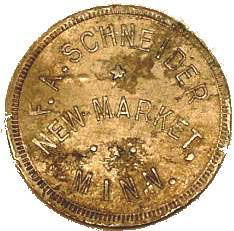
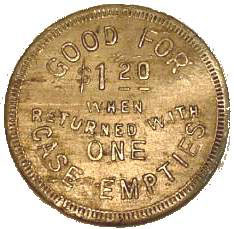
If you look on line at tokencatalog.com, and search $1.20 tokens, you find a lot (mostly from Minnesota!) that actually state that they were for bottle deposits. Legends are sometimes simple: “Good for $1.20 with case” to specific: “Good for $1.20 upon return of one Hamm case & bottles” to way too much information: “Due the bearer, the sum of $1.20 upon the return of this check together with one empty two dozen quart case with bottles in good and serviceable condition.” 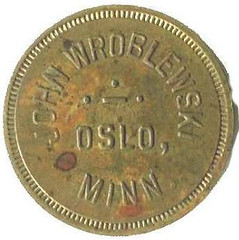
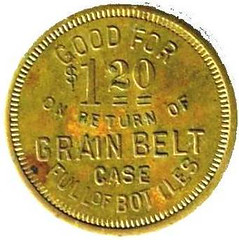
via tokencatalog.com. Before looking at the Library of Congress newspapers, I did not realize the connection between the Juneau Liquor Company and the Juneau Billiard Company. It seems likely to me that when JLC was in the liquor business, they had to deal with empty bottles. This function probably was inherited by the JBC, but “soft drink” bottles. While we can never really know why the $1.20 token was issued, this seems like a reasonable explanation. Now, about the $1.10 NAT&T token... AND WHAT ABOUT THAT $1.10 TOKEN? 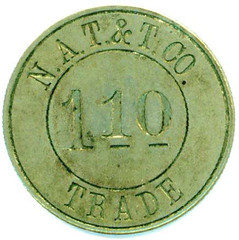
Theory 1: from Ron Benice In my research, after reading A.B. McCullough’s “Money and Exchange in Canada to 1900” I proposed the following in the April 1997 issue of ATC&PN: “He described the mid 19th century practice among Canadian bankers, merchants and exchange dealers of using the $4.8666 exchange rate for currency transactions or minor coins but a rate of $4.444 when dealing with silver dollars or American gold coins. Interestingly, the ratio between these two rates is $1.095 which rounds quite nicely to $1.10. He didn’t say when the dual rate system was discontinued, but did hint that some old financial practices persisted longer on the western frontier than in the rest of the country. So it remains an interesting possibility that the $1.10 tokens were used as change for payments in gold or silver while the $1.00 tokens were used with paper money and minor coins.” Editor’s comment: Keeping accounts based upon the British Pound, to which the Canadian Dollar was tied, seems a bit awkward. However, there would be an advantage to receiving silver dollars and American gold in payments if that is what your creditors were requiring. Theory 2: from Tony Chibbaro, South Carolina token researcher. The only other $1.10 tokens on tokencatalog.com (other than drink tokens) are from South Carolina. 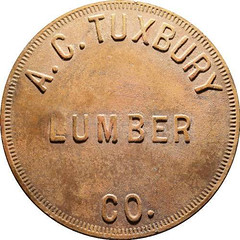
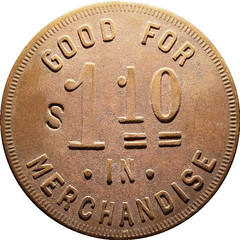
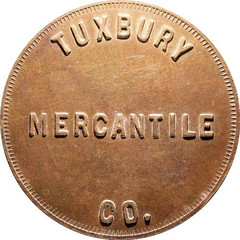
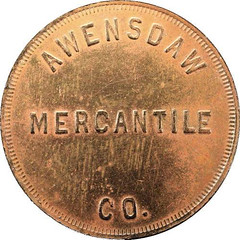
The only way that I can think of to account for the odd denomination of these tokens is to offer a discount to an employee, and in doing so making sure that your employee is not being profited upon by shopping at the store of the company that he worked for. (SC tokens compliments of Tony Chibbaro). Editor’s comment: Tuxbury and Awensdaw Mercantile (both $1.10 tokens) were the company stores of Tuxbury Lumber Co. Company stores have a reputation of exploiting the workers. Perhaps Tuxbury was an exception! Theory 3: from your editor If you tendered cash, and were willing to accept tokens in change, rather than a $1 token, you would receive a $1.10 token. This allowed the merchant to conserve his cash, and gave the customer a bonus. Tokens tendered received tokens in change. Editor’s Conclusion: Theory 1 would work for bankers, but I don’t see it applying to general commerce on the retail level. Theory 2 makes sense, allowing a worker a 10% bonus, perhaps for accepting tokens as his salary. In the North where cash was always in short supply, giving the customer a bonus for accepting tokens rather than cash would be good business practice. Alaskan Token Collector & Polar Numismatist, published 10 times per year, is a publication of Alaska Rare Coins. Contact Dick at akcoins@mosquitonet.com for subscription rates. I shared the articles with Dave Schenkman, who collects and studies odd denomination tokens. -Editor Dave writes: "The $1.10 token is quite a rare denomination. There's always a reason for the denomination, but it can be hard to know so many years after the fact." Dave shared images of a couple of his favorites. -Editor 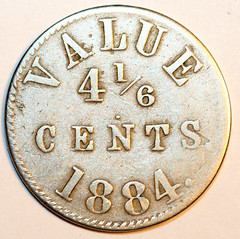
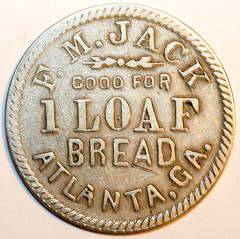
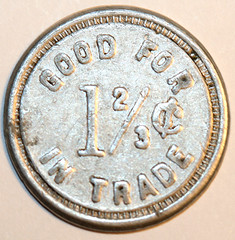
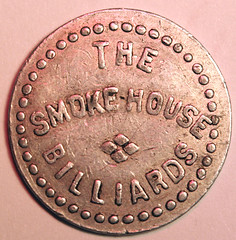
Dave adds: "Six of the Georgia token equaled 25¢. Three of the other one equaled 5¢." 
Wayne Homren, Editor The Numismatic Bibliomania Society is a non-profit organization promoting numismatic literature. See our web site at coinbooks.org. To submit items for publication in The E-Sylum, write to the Editor at this address: whomren@gmail.com To subscribe go to: https://my.binhost.com/lists/listinfo/esylum All Rights Reserved. NBS Home Page Contact the NBS webmaster 
|